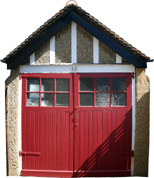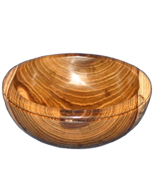A crotch is a fork in the branch of a tree and they often
feature spectacularly figured wood. The challenge for the
wood-turner is to ensure that the figuring is displayed
to maximum effect in the end product. The crotch for this
project came from a large Walnut tree (Juglans
regia), felled in Water Lane, Bovingdon in
March-April 2016.
![[Making a Walnut Platter - click for larger view] Making a Walnut Platter.](images/img_2822crthmb.jpg)
|
A Walnut Crotch.
This crotch of Walnut looked as if it might feature
some spectacular figuring.
(Click picture for larger view)
|
![[Making a Walnut Platter - click for larger view] Making a Walnut Platter.](images/img_2826crannthmb.jpg)
|
Spectacular Figuring!
Using an electric chainsaw, the crotch was sliced
longitudinally to reveal some figured heartwood
surrounded by pale-coloured secondary wood. The
platter described here was made from the arrowed
slice.
(Click picture for larger view)
|
![[Making a Walnut Platter - click for larger view] Making a Walnut Platter.](images/img_2862crthmb.jpg)
|
Making the Best of the Wood.
Next, the sliced log was cut into a circular disc
(platter blank) with the bandsaw using a circular
hardboard template. Note how the dark-coloured
figured heartwood is relatively thin and much of
this would be lost if the blank was used to make a
conventional bowl instead of a platter
(Click picture for larger view)
|
![[Making a Walnut Platter - click for larger view] Making a Walnut Platter.](images/img_2866crthmb.jpg)
|
The Cut Blank.
This shows the cut blank and again shows that the
best of the figuring (on the bottom of the blank in
the photograph), will be exhibited in a flat
platter rather than a bowl.
(Click picture for larger view)
|
![[Making a Walnut Platter - click for larger view] Making a Walnut Platter.](images/img_3245crthmb.jpg)
|
Trimming the Blank.
Using a jig on the bandsaw to cut away waste
secondary wood on the circular blank.
(Click picture for larger view)
|
![[Making a Walnut Platter - click for larger view] Making a Walnut Platter.](images/img_3252crthmb.jpg)
|
Drilling the blank.
Using a 60mm diameter Forstner bit with a drill
press to cut a circular recess in the centre of the
top of the blank. The jaws of the lathe chuck will
expand into this recess to hold the wood securely
whilst turning. Note how the best of the
figuring is towards the top of the blank.
(Click picture for larger view)
|
![[Making a Walnut Platter - click for larger view] Making a Walnut Platter.](images/img_3254crthmb.jpg)
|
Mounting the blank.
The blank mounted on the lathe, ready for turning.
The left side of the blank (closest to the chuck
jaws and exhibiting the best of the figured
heartwood), will form the top of the platter.
(Click picture for larger view)
|
![[Making a Walnut Platter - click for larger view] Making a Walnut Platter.](images/img_3257crthmb.jpg)
|
Rough-turned Base.
Base of the platter roughly shaped. Note the
rounded foot or spigot on the base which will be
used to hold the platter on the lathe whilst the
interior is hollowed out.
(Click picture for larger view)
|
![[Making a Walnut Platter - click for larger view] Making a Walnut Platter.](images/img_3260rotcrthmb.jpg)
|
Flipped.
The platter was then flipped on the lathe (held by
the chuck jaws gripping the spigot), ready for
hollowing out.
(Click picture for larger view)
|
![[Making a Walnut Platter - click for larger view] Making a Walnut Platter.](images/img_3261rotcrthmb.jpg)
|
Top Completed.
The platter after hollowing out, sanding and
oiling. Note how the hollowing is minimal so that
the heartwood figuring is particularly well
displayed, following the decisions made when
initially preparing the blank from the raw timber.
(Click picture for larger view)
|
![[Making a Walnut Platter - click for larger view] Making a Walnut Platter.](images/img_3266crthmb.jpg)
|
Flipped Again.
Platter flipped again and held securely by the Cole
(button) Jaws on the lathe to enable completion of
the base.
(Click picture for larger view)
|
![[Making a Walnut Platter - click for larger view] Making a Walnut Platter.](images/img_3276crthmb.jpg)
|
Base Completed.
Base of platter completed, and sanded.
(Click picture for larger view)
|
![[Making a Walnut Platter - click for larger view] Making a Walnut Platter.](images/img_1048-img_1049thmb.jpg)
|
Completed Platter.
Top and bottom views of completed platter (diameter
165mm, 6½"; thickness 20mm ¾"). The
platter has had several coats of Chestnut
Finishing Oil and has been buffed with a final coat
of Chestnut Microcrystalline Wax.
(Click picture for larger view)
|

